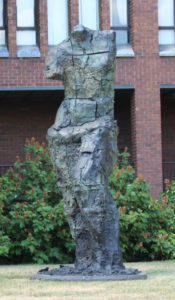
The Scene contributor
How about a little Art Appreciation 101? Most people have walked by the wooden-looking statue outside A Tower and the library, possibly not taking much notice of this withered yet human-appearing form, missing arms and legs like many famous old sculptures.
I like the appearance of the body moving or being twisted, and the creases and cracks both horizontally and vertically produce a nice effect. This is art that has been carefully crafted; sculpture molded to produce emotion in the viewer, as well as leading him to do his own reading of the art and interpret the artist’s purpose. This is what good art—and even bad art—sets out to do.
This beautiful sculpture is “Weathered Venus,” a large-scale bronze work produced by artist Jim Dine in 1990. According to the St. Louis Regional Arts Commission website, it is “a contemporary celebration of the traditional craft and form in sculpture.”
The work has a similar look and alludes to the famous model of female perfection, “Venus de Milo,” an ancient Greek marble statue that also has both arms missing. Dine’s tribute to the classic Greek artwork presents a new, unfinished rough look—like an early draft or a work in progress.
The Arts Commission website also describes Dine’s use of “abstraction to remove the popular connotation and clichés from well-known, historic pieces” and brings “attention to the beauty of the original ‘Venus de Milo’ by presenting it anew to the world…to be an important cultural legacy.”

Isn’t “Weathered Venus” a great metaphor for the struggling college student? We are all lifetime learners, works in progress; often imitating and being influenced by our mentors and teachers to become successful and reach our goals in education and life, working toward our masterpieces.
The rough, unfinished-appearing exterior of “Weathered Venus” looks like an artist model or early draft, working toward the amazing final product and salute to the classical female form, the “Venus de Milo” produced by Alexandros of Antioch between 130 and 100 BCE.
“Weathered Venus” is not a simple imitation or copy but a salute to an ancient work of art celebrating the wonders of the human anatomy. Dine’s piece itself is a new unique work of art, borrowing ideas and inspired by classics that have come before it; but the attention to detail and careful shaping demonstrate an artist using historic influence to create something new, beautiful and quite powerful.
His salute to the classical form is like the blues. That’s a musical style that may include a lot of borrowing and influences, but unique bits of greatness often spring—even in this mode of tribute or imitation. Inspiration in art may come in many forms, and isn’t an imitation something of a new or different creation when one is inspired and moved by one’s own interpretation of details?
So given the unfinished look of “Weathered Venus,” don’t worry about great creation at times going unfinished. Keep on working and striving, shaping yourself and your creations—enjoying the learning and experience in the process. Each day and each step along the path of life can be a new beginning.
As an artist of life and aspiring writer myself, there’s great value in revision, starting over and paying careful attention to detail. We are all lifetime learners in this journey of life, making our extra finishing touches to beauty and creation each step of the way.
